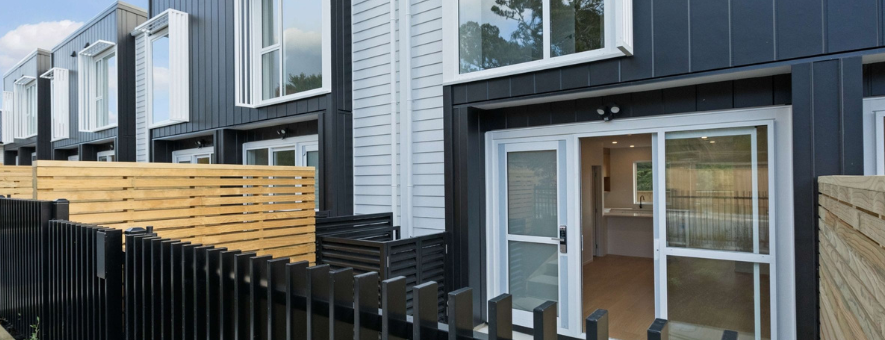When planning a construction project and dealing with design decisions, having the right team of experts on your side makes a significant difference. The question is, how can you be confident that your architect is the right fit for the job?
In this article, we share our list of top architects for residential and commercial developments, with a particular focus on energy efficiency and the updated H1 standards. To find the ideal architectural firm for your next venture, find our recommendations below.
New Zealand architects for H1 project specification
Here at UNO Windows & Doors, our team has worked with architects from all around New Zealand. In terms of experience and expertise in meeting the H1 standards, we have highlighted our top recommendations below:
Novak & Middleton
Based in Wellington, Novak + Middleton is an award-winning architectural practice. With over thirty years as partners, Novak + Middleton has extensive experience in all aspects of residential and commercial architecture, including large-scale multi-unit housing, architectural homes, alterations and interior architectural design.
Solari Architects
Also based in Wellington, Solari Architects are industry leaders in public and private medium-density housing, and mixed-use buildings of various sizes. With a focus on designing homes that offer high amenities, sustainability, reduced running costs and improved liveability, energy efficiency is a high priority for the Solari team.
Precinct Architecture
Founded in 2017, Precinct Architecture is committed to creating socially and environmentally responsible buildings with the future in mind. Located in Wellington, the team offer architectural expertise for various building types across New Zealand, including high-end residential homes, multi-residential developments, commercial buildings and educational facilities.
Warren and Mahoney
Founded in 1955 in Christchurch, Warren and Mahoney is New Zealand’s only third-generation architecture firm. Today, they have teams in Auckland, Wellington, Christchurch, Tauranga, Queenstown and Australia. As a leader in Environmentally Sustainable Design (ESD) and a driving force behind the New Zealand Green Building Council (NZGBC), the firm is actively engaged with innovations in energy-efficient design.
Jerram, Tocker & Barron Architects
With offices in Auckland, Wellington, Christchurch, Nelson and Wanaka, JTB Architects is an award-winning firm creating contemporary designs for commercial and residential projects. With extensive expertise in Environmentally Sustainable Design, the team has plenty of experience working to meet and exceed the H1 standards.
Sheppard & Rout Architects
Established in 1982 in Christchurch, the team at Sheppard & Rout has over 40 years of experience designing to New Zealand standards. The practice has carried out a wide range of projects across the country, from large-scale commercial buildings to individual homes and alterations.
Ardern Peters
Established in 2000, Ardern Peters Architects is a medium-sized architecture firm based in New Plymouth. Its services include architectural design and consultations for commercial, residential, and educational buildings. In 2022, the UNO team partnered with the firm to create a new classroom at Puketapu School, factoring in energy efficiency and sustainable design for the future.
Boon
In 1974, Terry Boon founded what is now the longest-serving architectural practice in New Plymouth. With experience across both commercial and residential projects, Boon is driven by a vision for the future.
Spacecraft Architects
Formed in 2012, Spacecraft Architects is experienced in residential, commercial and public architecture in New Zealand and abroad. The firm’s ethos is based on creating aesthetically pleasing, affordable architecture with consideration for the climatic and cultural context. Environmental responsibility underpins every project, no matter which climate zone applies.
Tadworks Architecture
Based in Lower Hutt, Tadworks Architecture provides design services for commercial buildings and multi-residential developments. From initial consultations to construction observation, Tadworks supports its clients every step of the way, including with consent and compliance.
Cant see your company here? Reach out to us today to get your company added to the list above.
The H1 requirements for windows
Since 2021, MBIE has been revising the H1 requirements for energy efficiency. The updated standards apply to both residential and commercial buildings, requiring significantly higher R-values.
Residential buildings
As of November 2022, the minimum window standard in all new build houses is R0.37. This was the first interim increase but it will increase again to the following R-values in 2023:
-
Zones 1 and 2 – R0.46 (1st November 2023)
-
Zones 3 and 4 – R0.46 (1st May 2023)
-
Zones 5 and 6 – R0.50 (1st May 2023)
For a full breakdown of the updates and how to comply with them, find out more about the H1 standards for residential projects in our recent article. For the official building code document, see Acceptable Solution - H1/AS1.
Small commercial buildings
For commercial buildings smaller than 300m2, the revised R-values are as follows:
-
Zones 1 and 2 – R0.37 (1st November 2023)
-
Zones 3 and 4 – R0.46 (1st May 2023)
-
Zones 5 and 6 – R0.50 (1st May 2023)
Find out more about the H1 standards for small commercial projects in our article, or see the official Acceptable Solution - H1/AS1.
Large commercial buildings
For commercial buildings larger than 300m2, the adjusted R-values are as follows:
-
Zones 1 and 2 – R0.33 (1st November 2023)
-
Zones 3 and 4 – R0.37 (1st May 2023)
-
Zones 5 and 6 – R0.40 (1st May 2023)
For a comprehensive explanation of the commercial updates, find out more about the updated H1 standards for commercial projects in our full explainer. For the official building code document, see Acceptable Solution - H1/AS2.
How to meet the H1 requirements for window insulation
To ensure your development is compliant with the H1 standards outlined above, certain building elements will need to be incorporated. To meet these expectations, consider incorporating a combination of the following:
-
Low-E glass
-
Argon gas double glazing
-
Thermally broken windows
- UPVC window frames
If it is possible to exceed the minimum requirements, we recommend taking the opportunity to increase the building’s energy efficiency and future-proof.
Questions to ask your architect
With the above factors in mind, take the time to discuss your options with your architect and window suppliers. Start by asking the following questions:
-
Are thermally broken windows worth it?
-
Is double glazing enough for your climate zone?
-
Is it possible to exceed the minimum standards?
Window and door suppliers
At UNO Windows & Doors, we are here to help you navigate the H1 standards with ease. We are experienced with these updates and can provide you with valuable recommendations to save you time and money.
Don’t hesitate to contact us today for personalised assistance and recommendations for your next project. Whether you are looking for a reliable and well-versed architect, or simply need advice on how to meet new requirements, UNO can help.
Ask us for our industry recommendations




